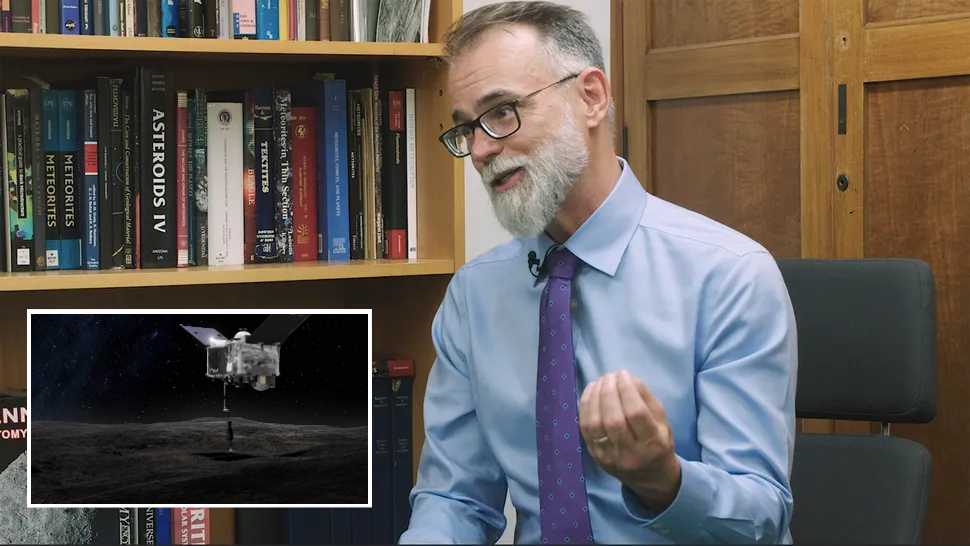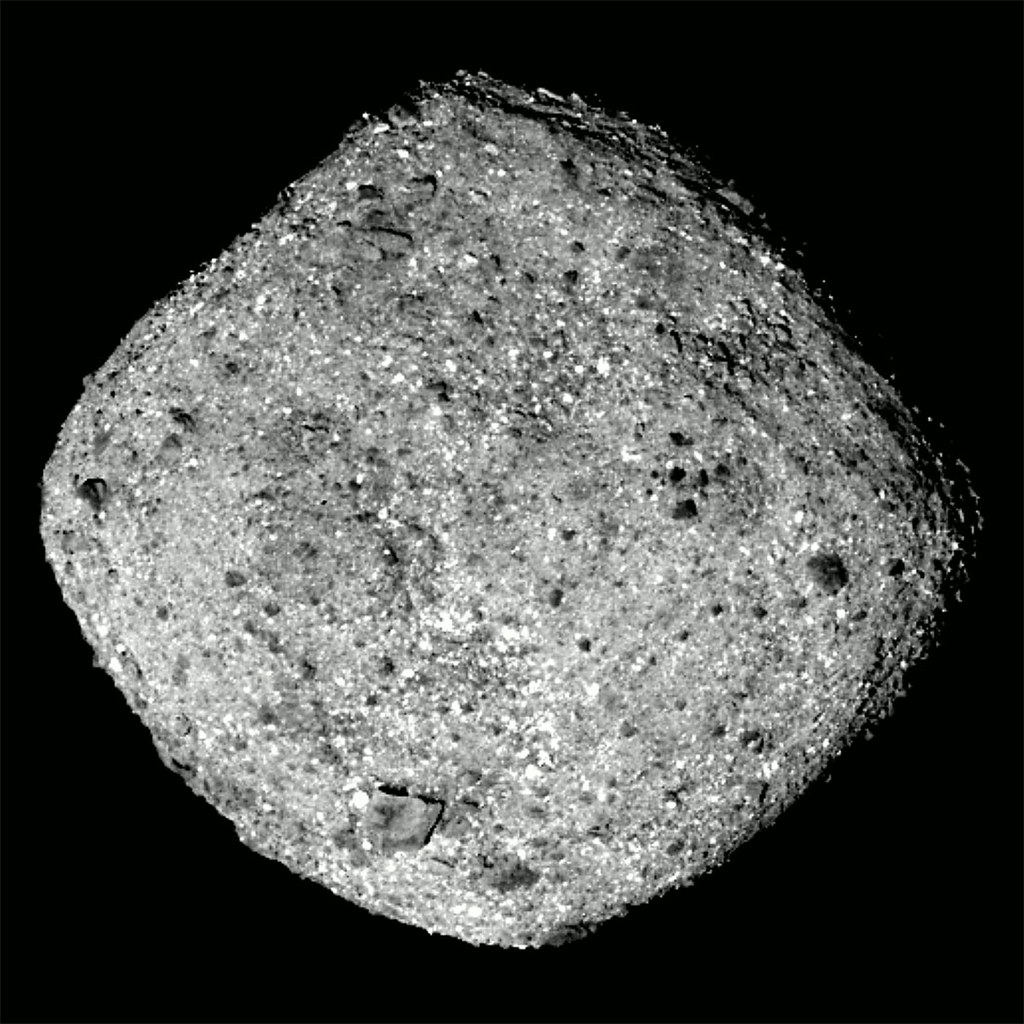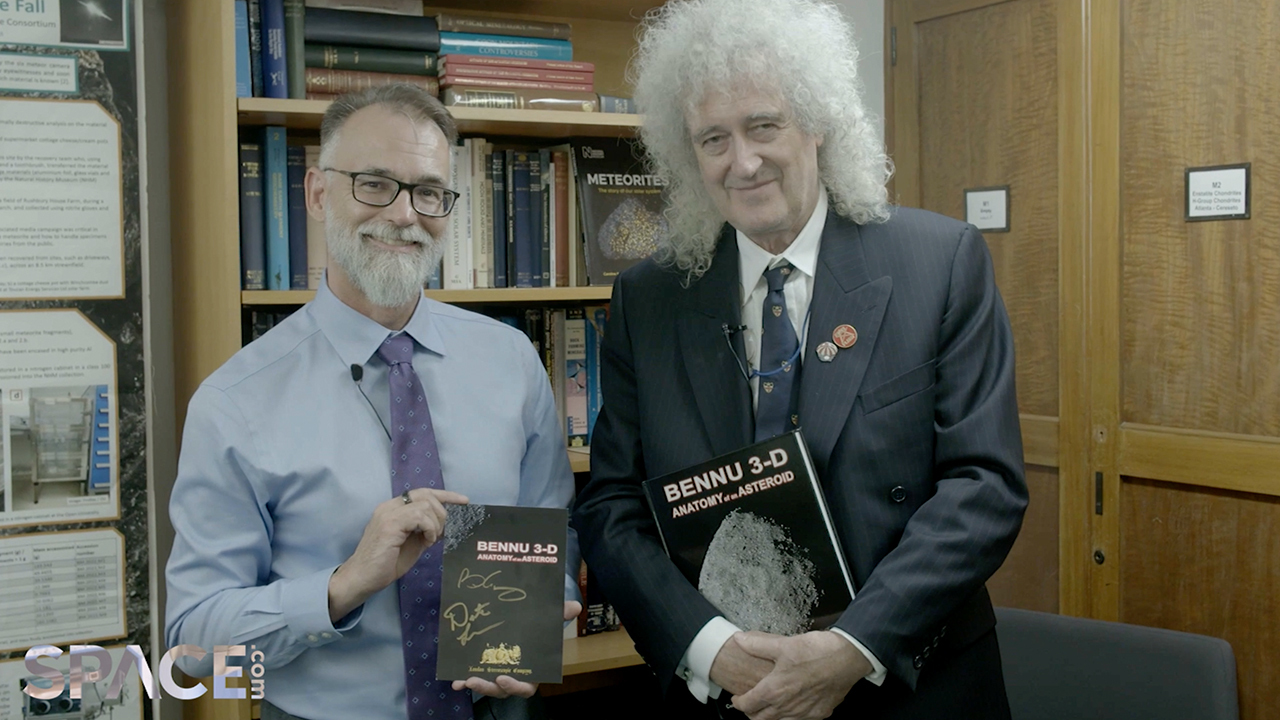
On Sept. 24, NASA's OSIRIS-REx spacecraft will drop off a piece of space rock at Earth. Ahead of the historic sample landing, Space.com caught up with Dante Lauretta, the mission's chief scientist, to learn about the obstacles that nearly thwarted the mission's effort.
Named after a mythical ancient Egyptian king murdered by his own brother, the OSIRIS-REx mission, too, had to deal with its share of challenges. In the case of OSIRIS-REx (short for Origins Spectral Interpretation Resource Identification Security Regolith Explorer), the treacherous enemy came in the form of the mission's target asteroid Bennu.
First, the 1,614 feet (492 meters) wide space rock forced engineers to reprogram the spacecraft to enable it to land on a surface that looked completely different from what the scientists had expected. Then, during the landing, or rather a brief touchdown, the asteroid surface nearly swallowed up the spacecraft. To top things off, after the sample collection, images from on-board cameras revealed that bits of the precious space dust were leaking into space.
A lot was at stake during the mission, including our understanding of the origins of life in the solar system. In our exclusive interview, Lauretta, who is also also a professor of planetary science at University of Arizona, reveals what OSIRIS-REx has already taught us about asteroids and when first scientific analyses of the sample may be available.

Space.com: OSIRIS-REx is about to deliver a piece of asteroid Bennu to Earth on Sept. 24. The mission launched in 2016 and spent two and a half years studying Bennu from its orbit. How much has the mission changed our understanding of asteroids?
Dante Lauretta: OSIRIS-REx rendezvoused with asteroid Bennu in December 2018 and right away, I knew that we were in for a real challenge. Even though we had done an extensive astronomical campaign to characterize this asteroid, we really had some major surprises. Most importantly, when we looked at the thermal data, the asteroid surface heats up and cools down really quickly, which we interpreted as [it being composed of] fine-grained material, kind of like a beach. In fact, I used the word beach repeatedly, when I was describing the surface earlier in the mission concept.
Instead, [when OSIRIS-REx arrived at Bennu] we saw something that was covered with large, rough and rocky boulders everywhere and there were no smooth areas of the kind that we designed the spacecraft to go down and sample.
It also became really apparent that [Bennu] is not a solid body. It is actually what we now term a rubble pile, and it seems that most small asteroids are this kind of objects, very loose accumulations of boulders and dust and gravel probably formed after a giant catastrophic collision in the main asteroid belt [a region between the orbits of Jupiter and Mars, where most solar system's space rocks reside] hundreds of millions of years ago.
Space.com: Are you saying that you actually designed the mission with a wrong assumption of how the asteroid would look like? Was there a real risk that you might not be able to touch down and collect the sample?
Dante Lauretta: When we designed the spacecraft, we had a design targeting accuracy [for the landing] of about 50 meters [164 feet]. We based that knowledge on a prior mission from a Japanese Aerospace Exploration Agency called Hayabusa, which was the first spacecraft to rendezvous with one of these small objects [Hayabusa 1 collected a sample from asteroid Itokawa in 2005]. This asteroid had nice 50-meter-wide smooth patches and we thought that Bennu must be more benign than Itokawa.
So we were really using that prior knowledge to drive our concept for getting to this asteroid and the telescoping data seemed to confirm that. The thermal properties, also the radar properties, it really looked like a smooth surface. So when I first saw that [the surface was completely different], I really thought we might be in trouble there.

Asteroid Bennu is a potentially hazardous near-Earth space rock that has a nearly 1 in 1,800 chance of colliding with Earth in the next 300 years. Bennu is a carbon-rich asteroid that likely contains organic compounds as old as the solar system itself. NASA's OSIRIS-REx mission will deliver about 9 ounces (250 grams) of dust and gravel from Bennu to Earth this September, and scientists hope that these fragments will help shed some light on the origins of life on our planet.
Space.com: How did you go about this challenge, trying to find a landing spot on this very rocky asteroid surface?
Dante Lauretta: When you launch a spacecraft, the only thing you can fix is the software, so we had to make the spacecraft smarter. When we launched, we planned to use a laser altimeter for the guidance down to the asteroid because we were expecting these big smooth areas. We just thought that we would need to know that we were coming down at the right rate towards the surface. Instead, we had to completely change the strategy, using the onboard cameras and performing an extensive mapping campaign, sometimes mapping features as small as a couple of centimeters to put into the spacecraft's memory so that it could make real decisions and guide itself down to the safe location, which turned out to be only ten meters [33 feet] across.
Even in that area, there were still hazards, spacecraft-killing boulders. We taught the spacecraft where they were and what they looked like and if the spacecraft determined it was coming down on a boulder it would actually reverse engines and fly away and come back and try to sample another day.
Space.com: When you were going through this process of finding a suitable location on the surface of the asteroid, you had a very surprising collaborator in Sir Brian May who is obviously known worldwide for his music as a member of the legendary rock band Queen. What work has he done for the team?
Dante Lauretta: Brian is an expert in producing stereo images along with his collaborator Claudia Manzoni. We didn't plan on stereo imaging [when we designed the mission]. We didn't design a stereo camera but [May] was able to find pairs of images that have just the right angular separation. When he corrected for the shadows and for the alignment and when you look at them through the stereoscope, all of a sudden, the surface appears to you in this brilliant three-dimensional view and you get a real understanding of how rough and rugged the surface is. And he really embraced the challenge and really, really helped us out.
Space.com: It almost sounds as if Brian May rescued the OSIRIS-REx sampling attempt.
Dante Lauretta: Brian and Claudia both played a critical role in sample site selection. We are very grateful for their efforts and absolutely, they opened our eyes to the true nature of the surface.

The OSIRIS-REx mission was NASA's first attempt to collect a sample from an asteroid. The mission launched in September 2016 and reached its destination, the near-Earth asteroid Bennu, in December 2018. The probe then spent two and a half years studying Bennu from its orbit. The data revealed that the space rock, the most dangerous known asteroid in the solar system, looks completely different from what the scientists had expected. A suitable enough landing site was eventually identified and the spacecraft successfully collected a sample in October 2020. OSIRIS-REx will drop off its Bennu sample at Earth on Sept. 24. It will then head to Apophis, another potentially dangerous space rock, for a rendezvous in 2029.
Space.com: The challenges didn't end with selecting the landing site. When you touched down, something happened. Remind us, what happened there and what did that teach you about asteroids?
Dante Lauretta: Yeah, what happened was very different from our early concept animations of the sampling. The [sampling] device is called a TAGSAM, the Touch-and-Go Sample Acquisition Mechanism. It's about 30 centimeters [11 inches] in diameter and it's basically an air filter. [When it touches the asteroid surface], we blow down gas, kind of like a leaf blower designed to push the [asteroid] material into that sample collection chamber. You can tell [from those early concept animations ] that we thought the surface was going to be nice and hard and provide resistance to the downward motion of the spacecraft. We thought that we would just collect a surface level of gravel and dust.
Instead, the surface of Bennu, which I call the trickster asteroid, responded kind of like dropping into a pool of water. There was absolutely no resistance to the downward motion of the spacecraft. We made contact at 10 centimeters [4 inches] per second. One second, we were 10 cm down into the surface and we continued to push down about 50 cm [20 inches] deep. Thankfully, the backaway thrusters still fired and we were able to safely retreat from the surface with our precious cargo in hand.
Space.com: Based on your experience with Bennu and OSIRIS-REx, do you have an idea what would have happened if an asteroid like Bennu would have been the target of the DART mission? The other NASA asteroid mission designed to deflect a potentially dangerous asteroid?
Dante Lauretta: The DART mission was a huge success. That was NASA's first attempt at planetary deflection using a kinetic impactor to change the velocity of an asteroid, the same kind of technology we would like to employ if there was a real asteroid threat.
When I saw the images of Dimorphos [the DART mission's target], which is a satellite of a larger asteroid, it looked really familiar, it looked like a bouldery pile of rubble, more shaped like an American football than Bennu, but still that same kind of characteristic texture. The mission was phenomenally successful. It imparted a lot of momentum to the asteroid, substantially slowed its orbital velocity and a large part of that is because there was so much material that was ejected from the surface and that transfer of energy resulted in a significant change of the orbital period.

Space.com: I guess that's important because Bennu might actually in the future be a target of such a deflection mission for real, is that right?
Dante Lauretta: Yes, Bennu is known as the most potentially hazardous asteroid in the solar system. I don't want people to panic, the odds are still low, about 0.05%, but if an impact is going to occur it will be in the year 2,182. So we have a lot of time, and we are now just starting to develop the technologies and strategies [to deal with this threat]. I think that people of the future will be well-equipped to deal with Bennu, especially because of the enormous amount of information that we have collected [at Bennu]. I like to think of it as one of our gifts to the future generations.
Space.com: OSIRIS-REx will deliver its precious piece of asteroid Bennu to Earth in September. How are you guys preparing for this big moment?
Dante Lauretta: It's kind of a culmination for me of almost 20 years of my career, getting ready for this big event on Sept. 24. The spacecraft is on its journey to Earth. It's getting closer every day. About four hours before it hits the top of the atmosphere, it will release the sample return capsule, which is about 80 centimeters [30 inches] in diameter and it looks like a mini version of the capsule that astronauts come back from space in.
The spacecraft will then fire its engine and continue to orbit the sun [it will head to Apophis, another potentially hazardous asteroid]. The capsule will hit the top of the atmosphere at 27,000 miles per hour or about 12.4 kilometers per second, and it will parachute into the Utah desert in the southwestern United States.
We have been rehearsing and practicing, we have to interface with the United States military because it's their land that we are coming in on and we've been going out and doing the exact same procedure that we expect to do on the event. We have built a beautiful clean room at NASA's Johnson Space Center to receive the samples and we've done a lot of rehearsing.
My science team [at the University of Arizona] gets 25% of the sample but we've never really defined which 25%. How do you define the 25%? We've been going through a lot of decision making, scenarios and rehearsals, tensions. What is it going to be like if everybody wants the same thing? Kind of to get that out of the way so that by the time we are doing this for real, I know I will be in a highly emotional state, you want to have that muscle memory, you just want to go on an autopilot, you want to know what to do, you got a job, get it done and then the real holiday begins. We want to get these samples into our laboratory, the ones that we have been dreaming about since 2004.
Space.com: When do you think we can expect the first science results from the sample?
Dante Lauretta: I am advocating for as quickly as possible. If everything goes according to plan, we will have the science canister opened up on day two. This is the protective aluminum shell where the TAGSAM and the sample are contained. One of the other surprises that we had was when we backed away [from Bennu] and we looked at the sample collector, there was material that was escaping, so we kind of went into an emergency mode to quickly stow [the sample]. I think there is going to be dust all over the inside of this canister and our plan is to sweep it on day two. We have a set of amazing instruments right there in Houston and I think we are going to have information within a few days, at least the basic understanding — did we get back what we expected or will Bennu continue to surprise us?







